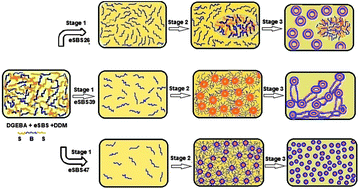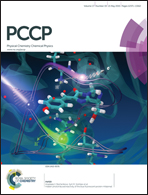Volume shrinkage and rheological studies of epoxidised and unepoxidised poly(styrene-block-butadiene-block-styrene) triblock copolymer modified epoxy resin–diamino diphenyl methane nanostructured blend systems†
Abstract
Styrene-block-butadiene-block-styrene (SBS) copolymers epoxidised at different epoxidation degrees were used as modifiers for diglycidyl ether of the bisphenol A–diamino diphenyl methane (DGEBA–DDM) system. Epoxy systems containing modified epoxidised styrene-block-butadiene-block-styrene (eSBS) triblock copolymer with compositions ranging from 0 to 30 wt% were prepared and the curing reaction was monitored in situ using rheometry and pressure–volume–temperature (PVT) analysis. By controlling the mole percent of epoxidation, we could generate vesicles, worm-like micelles and core–shell nanodomains. At the highest mole percent of epoxidation, the fraction of the epoxy miscible component in the triblock copolymer (epoxidised polybutadiene (PB)) was maximum. This gave rise to core–shell nanodomains having a size of 10–15 nm, in which the incompatible polystyrene (PS) becomes the core, the unepoxidised PB becomes the shell and the epoxidised PB interpenetrates with the epoxy phase. On the other hand, the low level of epoxidation gave rise to bigger domains having a size of ∼1 μm and the intermediate epoxidation level resulted in a worm-like structure. This investigation specifically focused on the importance of cure rheology on nanostructure formation, using rheometry. The reaction induced phase separation of the PS phase in the epoxy matrix was carefully explored through rheological measurements. PVT measurements during curing were carried out to understand the volume shrinkage of the blend, confirming that shrinkage behaviour is related to the block copolymer phase separation process during curing. The volume shrinkage was found to be maximum in the case of blends with unmodified SBS, where a heterogeneous morphology was observed, while a decrease in the shrinkage was evidenced in the case of SBS epoxidation. It could be explained by two effects: (1) solubility of the epoxidised block copolymer in the DGEBA leads to the formation of nanoscopic domains upon reaction induced phase separation and (2) the plasticisation effect of the epoxidised block copolymer in the epoxy resin.


 Please wait while we load your content...
Please wait while we load your content...